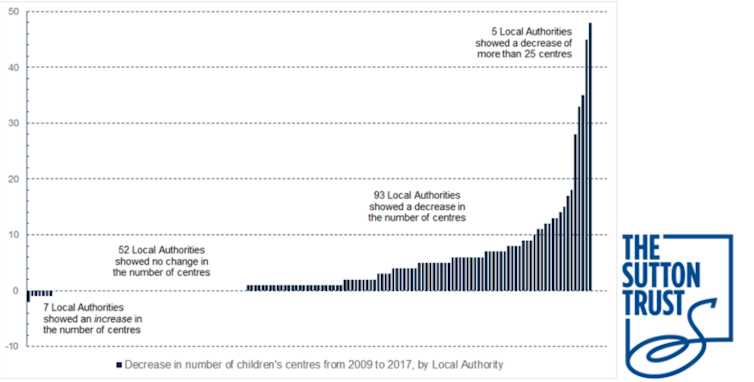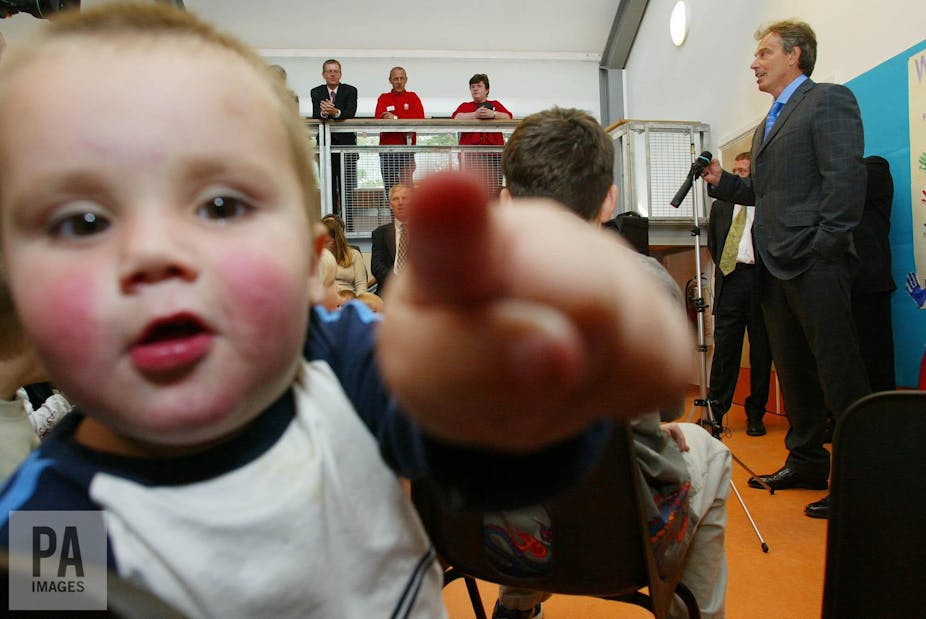Up to 1,000 children’s centres in England, designed to provide support to parents and young children, have been shut since 2009, according to recent research for the Sutton Trust charity. These closures have often been somewhat hidden, with centres merged, renamed or their focus shifted. Yet such changes represent a significant loss which will impact the lives of many parents and young children.
Sure Start centres first appeared in 1998 in England, as part of a flagship Labour policy to focus resources on children under five and their parents. The centres, which were initially only in certain deprived areas and were later rolled out nationally, provided support to parents and young children, including play sessions, parenting support, health, education, employment support and more.
They were designed to be in “pram-pushing distance”, and for many became a lifeline during the difficult and isolating early days of becoming a parent. My research found that open access “drop in play” sessions were often particularly valued as key spaces for support and socialising for parents from a range of backgrounds, as well as a point of access to other services.
The centres became a victim of austerity cuts from 2010 onwards, as local authority budgets were squeezed and funding was no longer ring-fenced for the centres. These cuts have often involved reorganisations, the merging of centres and some closures.
In the meantime, messages from central government have been confused or absent. A government review of the centres was announced in 2016, but never took place. OFSTED inspections ceased in 2015, a clear signal of the withdrawal of resources around the centres.

Rebranded centres
However, in recent months, something different appears to be going on. The authors of the Sutton Trust report suggest that since autumn 2017, there is strong evidence pointing to “a rapid increase in the number of closures and reorganisations to children’s centres”. Not only have numerous local authorities made reductions to services, they have dismantled existing children’s centre provision entirely. Many local centres have been shut, while others have been rebranded.
New names are being given to children’s centres including hubs, super-hubs, satellite centres, well-being centres, family places, early help bases, or outreach centres. It’s often unclear what these new names mean for the people who use them.
Such service “transformations” have different emphases, but common features, such as the closure of the majority of existing local centres to be replaced with a smaller number of “hubs”. For example, Oxfordshire replaced 44 centres with 19 hubs in 2017 – despite the intervention of former prime minister David Cameron’s own family – and Buckinghamshire is currently proposing to replace 35 centres with nine hubs.
Within such new centres, early childhood services are being brought together with wider youth and family services, particularly social work and care. There has also been a move away from universal or open access to “targeted” services for those deemed most in need, while reduced outreach or “satellite” services – such as health visitor clinics – may be provided from other sites. Councils which appear to have restructured or are in the process of restructuring their services along these lines also include Somerset, Birmingham, Warwickshire, Shropshire, and Medway in Kent, with many other councils also considering such radical changes, according to the Sutton Trust.
Austerity cuts to local government budgets are clearly very difficult to manage. What’s striking, however, is that many councils claim that the new, reduced, rebranded centres will actually constitute a better service than the previous ones. Both the renaming and the surrounding claims about improving services partly stem from the statutory duties on local authorities to provide “sufficient children’s centres to meet local need”, and to protect vulnerable and disadvantaged families in particular. Statutory guidance also sets out what kind of services a children’s centre must provide in order to be named so. Take away that name and a centre can provide anything – or nothing.
Councils now appear to be walking a tightrope in relation to these obligations. The slippery language of transformation and service improvement obscures local parents’ understanding of what the changes will mean for them and their children. Despite this, there has been vehement opposition to the closures in many local authorities, with campaigns led by parents. Because the bottom line is that the current changes, so clearly motivated by cost saving, are going to result in fewer services, for fewer parents, in fewer locations.
Services in the new hubs or centres will no longer be provided at “pram-pushing distance” and will mostly involve “referral” or “invitation” from other professionals such as social workers and doctors in order to access sessions. Although it may sound logical to focus reduced resources on those “in greatest need”, the research evidence shows that supporting families and intervening in parenting where necessary is actually quite a delicate balancing act. As my own research has also shown, parents considering using services may not feel they want help, feel judged by professionals, and be concerned about the power of the state to remove children. In order to reach families most in need, it may be that universal services, that do not stigmatise parents, are actually most effective.
Who defines need
The stories I’ve heard in my current research about the importance of the centres for parents and young children raise important questions about how “needs” are defined in relation to parenting and early childhood. I’ve heard about mothers experiencing isolation, poor mental health, and oppressive or even violent home lives. The centres offer support, both from professionals and peers, in tackling these issues and have provided friendship, for both mothers and children. And while friendship, especially between mothers, is something that society is used to trivialising, for many of the parents I have interviewed, it was fundamental to their survival as parents.
All this puts into question the extent to which the new, reduced, hubs will meet local need. Campaigners up and down the country have been asking for evidence to support the claims that the new services will be better. The reality is that no such evidence exists, unlike the Sure Start programme which was subject to a whole series of robust national evaluations.
The other statutory duty on local authorities in relation to centres is that they must undertake a local consultation about changes to children’s centre services, and that they must listen to the views of local families in making changes. Families in areas undergoing changes should therefore use these consultation processes to ask the tough questions about what is being lost and who will lose out, and be wary of the claims of positive transformation surrounding cuts. Once the doors to local centres are shut, it is unlikely they will be reopened.

